|
|
Apartments in Florence, Perugia, Rome, Sorrento and Positano |




|
|
|
|
- You are in: Home » Umbria » Assisi
VISIT ASSISI
« All the regions
SAINT FRANCIS CATHEDRAL
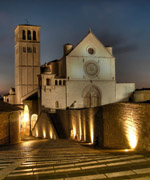
Pope Gregory IX laid the first stone of the Lower Basilica the day after the canonisation of St Francis, on July 17th 1228. Two years later the saint's body, that had been resting in the church of San Giorgio (the futre church of St Claire's) was brought here in secret for fear of looting by tomb raiders and buried in the unfinished church. Both churches were consecrated by Pope Innocent IV in 1253, before work was started on the large cycle of fresco decorations. The colonnade in the lower square is from the 15th century, as well as the oratory of San Bernardino opposite the entrance to the Lower Basilica, built for the Third Order and with 17th century alterrations in the interior. In the Lower Basilica, half way along the nave, a stairway leads downwards to the crypt containing the remains of St Francis, discovered only in 1818. The crypt was in fact designed in 1822 by Pasquale Belli, and re-worked in neo-Romanesque style by Ugo Tarchi between 1925 and 1932. The left side of the transept was on the other hand completely decorated by Lorenzo Lorenzetti and his workshop between 1315 and 1330. The cycle represents the "Passion of Christ“. Other works by Lorenzo Lorenzetti are in the chapel of St John the Baptist. Once decorated with frescoes depicting an allegory of the Crucifixion, the walls of the apse are now covered with a "Last Judgment" by Cesare Sermei di Orvieto.
The layout of the Upper Basilica is an exact reflection of the original plan of the Lower Basilica. The transept's and choir's decorations are entirely by Cimabue and his workshop (~1280). The grandiose cycle is sadly in a poor state of conservation on account of the lead oxide used to mix the lighter shades and the colours used to paint the flesh, that have all oxidised black. Left hand section: "Crucifixion“, five "Apocalyptic Scenes“ and "St Michael and the Dragon“. The walls of the nave contain a cycle of 34 episodes from the Old and New Testament painted above the gallery on the left and right hand side respectively, attributed to painters of the Rome School and followers of Cimabue.
top
SAINT CLAIRE CATHEDRAL
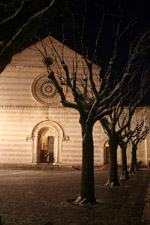
Construction work on the church and adjacent convent of St Claire began in 1257, three years after the saint's death and a year after she was canonised. Until then the sisters of St Claire had lodged at San Damiano. The church dedicated to St Claire occupied the site of the church of San Giorgio, where St Francis had been buried before his remains were moved to the basilica in 1230. The exterior of the building makes use of alternate strips of pink and white stone, with massive supporting arches either side. On the right hand side of the nave the "Cappella del Crocifisso" and the "Cappella del Sacramento" were once part of the nave of the previously existing church of San Giorgio, where Pope Gregory IX canonised St Francis in 1228. Relics of St Francis and St Claire are kept behind the grate. The following chapel contains a fresco by Puccio Capanna (1340-46): "Enthroned Madonna and Child with St Claire, St John the Baptist, the Archangel Michael and St Francis", as well as other frescoes of the school of Giotto and Lorenzetti. The right hand transept contains a panel with the "Life of St Claire“, by the so-called Maestro di Santa Chiara (late 13th century). A colonnade of 12 polygonal columns carved by a local workman in the 15th century encloses the high altar. The wrought iron dividing curtain is 17th century. A detached 14th century fresco of the "Nativity“ displays influences of Giotto in the left hand transept. The Byzantine style Hodegetria type panel on the left hand wall depicts the "Madonna and Child“ and is by an unknown artist from the 13th century. The lunettes are decorated with scenes from the Old Testament similar to those in the upper cycle of the Upper Basilica of St Francis (late 13th century). The crypt was built between 1850 and 1872. Restored in neo-gothic style in 1935, it houses the body of St Claire, discovered in 1850.
top
VIA SAN FRANCESCO
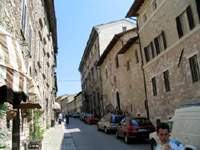
Coming from the Basilica of St Francis, Via San Francesco runs all the way to Piazza del Comune. Immediately on the left stands the Casa dei Maestri Comacini, which in the 15th century belonged to the master builders working in the Assisi area. The long Baroque facade that follows Palazzo Giacobetti (by Giacomo Giorgetti, 17th century), with a massive central balcony supported by corbels. This is the seat of the city library, the archives of the Sacro Convento, the city archives and the notary archives. Among the many treasures kept here there is the Bible of St Ludwig of Toulouse, with French 12th century miniatures, as well as the oldest text containing the writings of St Francis and the Canticle of the Creatures. On the other side of the street stands the Oratorio dei Pellegrini, built in 1432 by the brotherhood of San Giacomo e Sant'Antonio. The fresco on the facade depicts "Christ Resurrected, St James and Brother Anthony" and is by Matteo da Gualdo (1468). The interior is almost entirely covered by frescoes. The altar wall is also by Matteo da Gualdo, while the scenes depicting St James and St Anthony are the work of Pier Antonio Mezzastris (1471). St James and Sant'Ansano on the interior wall of the facade are now attributed to Andrea d‘Assisi, known as l‘Ingegno, whom Vasari considered the best pupil of Perugino. A little further on stand the seven arches of the portico of Monte Frumentario, an ancient hospital and resting place built in 1267, followed by the fine fountain Fonte Olivera of 1570. After 200 mt you arrive to Piazza del Comune.
top
SAN RUFINO CATHEDRAL
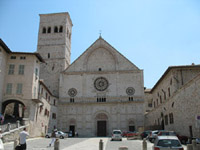
Two churches preceded the actual Romanesque church: the first of the 8th century, the second, a three-aisled basilica built by Bishop Hugh around 1030 to where the cathedral was transferred from S. Maria Maggiore in 1036 and of which the crypt and the bell-tower are still existing, while the nave stood underneath the actual church-square. The construction of the actual Cathedral of Saint Rufino begun under Bishop Clarissimus in 1134 by Giovanni da Gubbio. The front is of classical Umbrian-Spoletian style and is richly decorated with sculptures and bas-reliefs. The first paneled order ends with a cornice decorated with monstruous animals. A blind gallery is the base for the second order with a central rose-window, surounded by the four symbols of the Evangelists, flanked by a pair of smaller rose-windows. The three-aisled basilica interior in 1571 has been drastically modified by Galeazzo Alessi in late Renaissance style. The only original element in the church is represented by the font at the beginning of the right aisle: in it have been christened St. Francis, St. Clare and Frederick II of Swabia, who had grown up in the imperial fortress of Assisi. On top of the last altar on the right, „Christ and saints" by Dono Doni (1555), by the same Assisian painter, at the two altars flanking the main one, „Deposition" (1563) and „Crucifiction" (1563). The entrance to the Museo Capitolare lies in the right aisle. The museum contains stripped frescoes from the Oratorio di S. Rufinuccio, probably by Puccio Capanna (1330-40), „Flagellation", „Crucifiction" and „Deposition". The vault of the apse is decorated with the remains of frescoes representing the symbols of the Evangelists (11th -12th century).
top
THE MINERVA TEMPLE
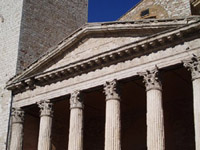
Built in the late Republican period in the 1st century BC, this temple was erected by the quatorvirates Gneus Cesius and Titus Cesius Priscus at their own expense. When a female statue was unearthed here it was thought the temple had been dedicated to Minerva, although the subsequent discovery of a votive plaque to Hercules makes it more likely that the temple had been dedicated to him. The façade has survived surprisingly well, with its six fluted columns supporting corinthian capitals and standing on plinths that rest on the steps leading to the pronaos for lack of space. In 1539 the inner sanctum of the temple was transformed into the church of Santa Maria Sopra Minerva, with further alterations added in the Baroque style during the 17th century.
top
|
|
|
|
|
|
| TOP DESTINATIONS
|
| Adria Coast, Aeolian Islands, Alessandria, Altopiano Delle Rocche, Amalfi Coast, Aosta, Assisi, Asti, Bari, Brescia, Capo Vaticano, Capri, Catanzaro, Chianti, Cilento, Cinque Terre, Coast Of Marche, Conero Coast, Dolomites, Egadi Islands, Elba, Florence, Garda Lake, Gargano, Ischia, Italian Riviera, Lake Como , Langhe Piedmont, Lecce, Lucca, Lunigiana, Macerata, Mantova, Maremma Tuscany, Monferrato, Montepulciano, Naples, Perugia, Pesaro Urbino, Pisa, Pistoia, Positano, Prato, Procida, Riviera Of Palms, Rome, Salento Coast, Salerno, San Gimignano, Sardinia, Sicily, Siena, Sorrento, Terni, Tiber Valley Of Tuscany, Treviso, Turin, Val Gandino, Veneto, Venice, Viterbo |
|
|









